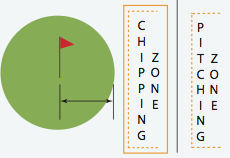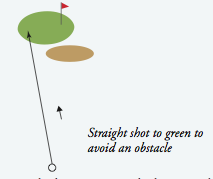Around the Green
When an approach shot misses the green, golfers usually have two options to put the ball on the green, a chip shot or a pitch shot. Generally, a chip shot runs more than it flies, and a pitch shot flies farther than it runs. Chips are usually played with a stroke similar to that of a putting stroke, while pitch shots are like mini-swings. Finally, chips are played with lower-lofted clubs, while pitches are played with sand or lob...
Approach Shots
If there was one rule of thumb that needs to be followed when hitting an approach shot, it would be to avoid “short-siding” yourself at all costs. What is short-siding? Short-siding is missing the green on the same side that the hole is, which means that the player will have little green to work with for a chip or a pitch. Short-siding is not always avoidable, but it should be minimized if at all possible. Depending on the skill of...
Off the Tee
Golfers today are enamored with distance. Many of them think nothing of plunking down several hundred dollars every time the latest and greatest driver comes along. Promising junior golfers are led to believe that they cannot compete at a high level unless they hit the ball over 300 yards on average. Television coverage is replete with announcers telling us that the bunkers 280 yards away are not in play for the majority of the field,...
The Road to Repeatability
We all strive for that marvelous feeling of the machine- like repeatability available to us as players and teachers, when the golf swing is working as designed. We, as teachers, are trying to sell this possibility to our students that we possess the keys to that magical, almost mystical exclusive goal of a truly repeatable golf swing. We know it exists, yet few have been its master. Why is a truly repeating swing so difficult to...
Keeping Juniors in the Game
Golf club managers are aware of the boom in junior golf memberships, and while some children are wielding clubs at the age of three, it is probably only from age five onwards when lessons will be able to add real value. Golf provides juniors with a grounding and understanding that it is a social game with solid rules of conduct and proper etiquette. Being part of an established club, mixing with adults, and learning how to respect...
Teaching with the FLAT STICK
You would think that an activity seemingly as simple as putting would have widespread agreement as to how it’s best done…but, as with many things in golf, that’s not the case. All sorts of conflicting instruction is offered, which can leave students (and, frankly teachers!) confused and frustrated. Let’s start with the very basic. All putts have only two components to them: distance and direction. It would be fair to say that...
Take the “Routine” Out Take the “Routine” Out of Warm-Up Routines
Ben Hogan was famous for being meticulous, and his warm-up routine proved no exception. He got to the course an hour ahead of time and warmed up for 40 minutes – 20 on the driving range, 20 on or near the putting green. Once, during World War II when he played an exhibition, he arrived late at the course and was told he could not warm up. He proceeded to shoot a 78, grumbling all the time about not being able to go through his normal...
My Oldest and Favorite Teaching Aid
During my school holidays as a kid, I used to work in the St. Andrew Golf Company in Dunfermline, Fife, Scotland. They made some of the finest persimmon woods and forged irons in the world. From an early age, I was shown how to assemble, adjust, and repair clubs of all types and sizes. When I started teaching, one of my teaching aids was a club I had assembled from that factory. That teaching aid is now 39 years old from origin. You...
The Olympic Mindset for Golf
Everyone gets nervous: You, me, and even Olympic athletes, including the great Michael Phelps. We all get butterflies when the situation is important to us. That is human nature. The difference is how we view this nervousness. There is a wise saying in sports psychology: “It is okay to have butterflies; just make sure they fly in the right formation.” Successful Olympians in London this past year needed to have command over their...
The steady head.. reality or myth?
Jack Nicklaus, in his influential 1974 book Golf My Way, believed that the one inviolable fundamental was to keep a steady head, even devoting an entire chapter to it. One of Arnold Palmer’s bedrock fundamentals was to keep his head still. All across driving ranges everywhere, there is sure to be someone advising a friend to “keep your head still” or “keep your head down.” It’s the one “fundamental” that is seemingly beyond question,...













